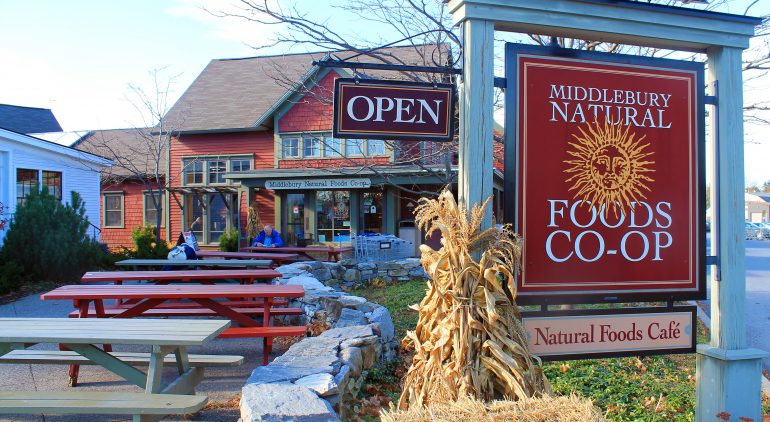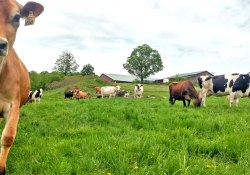
Happy Co-op Month!

October is Interational Co-op Month! We’re celebrating all month long with special store promotions on products made by cooperatives like Organic Valley, Equal Exchange, Alaffia, Frontier, Blue Diamond, Cabot, La Riojana, and Real Pickles, to name a few. We’re also celebrating this special month by spreading the word about the cooperative business model and what makes it so unique.
There are over 2.5 million cooperatives around the globe, including food co-ops, agricultural co-ops, housing cooperatives, artists’ co-ops, credit unions, and even cooperative sports teams! Despite our diversity, we are all unified by the Seven Cooperative Principles, which are a set of ideals that form the basis for how cooperatives around the world operate. They were first created in 1844 by the founders of the very first co-op, the Rochdale Society of Equitable Pioneers in Rochdale, England, and we are still guided by this same set of principles today.
In short, cooperatives exist to meet the needs of their member-owners and their communities. They are democratically controlled by their member-owners through an elected Board of Directors, and the profits generated by a cooperative are equitably distributed back to the member-owners and the community through patronage dividends and community philanthropic activities. When you choose to shop at our Co-op, you’re supporting local and sustainable food systems, fair compensation for employees, environmental stewardship, and a vibrant local economy.
We recently came across the following article about The Power of the Cooperative Movement by Robert Miller. Miller is a resident of Shelburne and is CEO of VSECU. He is a former commissioner of the Vermont Department of Economic Development and currently serves on the boards of the Vermont Center for Emerging Technologies, Capstone Community Action and the Energy Action Network. We enjoyed Robert’s article so much that we reached out to him and asked for his permission to share it:
The Power of the Cooperative Movement
Imagine a strategy that could transform a country’s poorest regional economy into one of great wealth and prosperity. An approach that could build a community that produces more than 9 percent of that country’s Gross Domestic Product (GDP), 12 percent of its exports, and 30 percent of its patents, while only comprising 7 percent of its population. This scenario is no fantasy. It’s the reality in Emilia Romagna, Italy. What’s their secret? A thriving cooperative economy. Their success is largely attributed to the region’s commitment to building co-ops and employee-owned firms since 1950. In fact, co-ops now account for 30 percent of Emilia Romagna’s GDP.
The region is just one of many examples, from Spain to Cleveland, that demonstrate how a thriving cooperative economy can spur economic and community development. Co-ops are certainly not a new phenomenon – the first was established in 1844. Nor do they offer a “magic bullet” to fix all economic woes. But as Vermont continues to work to strengthen its economy, stabilize our population, and create more opportunity for Vermonters, it is important to recognize the value of cooperatives as an essential element of economic and community development. With greater emphasis on the cooperative economy, we can work together to support a sustainable, locally owned, and locally controlled business sector, contributing to vibrant local communities that support all Vermonters.
The good news is that cooperatives and employee-owned firms already play an important role in our communities, with more than 130 cooperative organizations currently operating in the state, according to a new census from the Cooperative Development Institute. The Association of Vermont Credit Unions reports that 54 percent of Vermonters belong to at least one cooperative credit union. Many Vermonters may support cooperatives without even realizing it, including companies such as Ace Hardware, Ocean Spray and REI; and locally, Cabot Creamery, Mad River Glen Ski Area, and PT-360.
Our existing cooperative economy offers a great foundation. Yet when you consider the value co-ops add to local economies, the potential impact of growing this sector is significant. As local businesses, co-ops provide an attractive economic multiplier effect. Approximately 48 percent of money spent at local businesses is recirculated within the local community, compared to only 14 percent from national businesses. Cooperatives also bring stability by offering stronger success rates than traditional businesses. Data from the World Council of Credit Unions found that within five years of opening, 90 percent of cooperatives were still in operation versus 3-5 percent of non-cooperative businesses.
Co-op profits are more equitably distributed across a broader ownership base than traditional businesses. And with democratic, local control, cooperatives are also more likely to stay in the region for the long term. Beyond economic value, community development and support are part of the cooperative DNA – a set of inherent characteristics that speak to our Vermont values and further benefit our communities.
But we are all in this together. Local economies thrive when local businesses see strong local support – whether owned privately, by employees, or by cooperative members. We all play a role in building a diverse and dynamic local economy.
So go local! Support your local businesses. Discover and join a co-op. More broadly, let’s work together to strengthen our economy for all Vermonters.



